Kraków 2008-10-17
125b Section 1955-06-01
Iliuszyn Ił-14
Poland
Transport plane. Successor to the Il-12 aircraft.
History
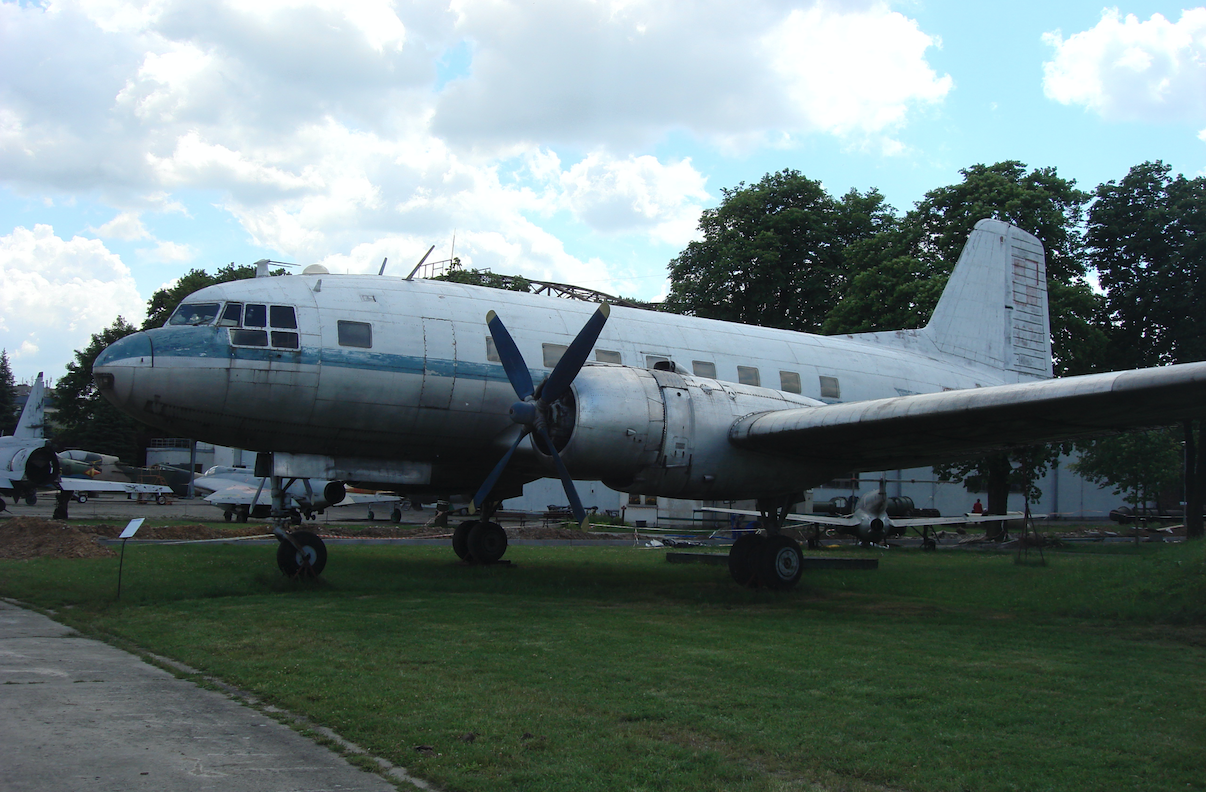
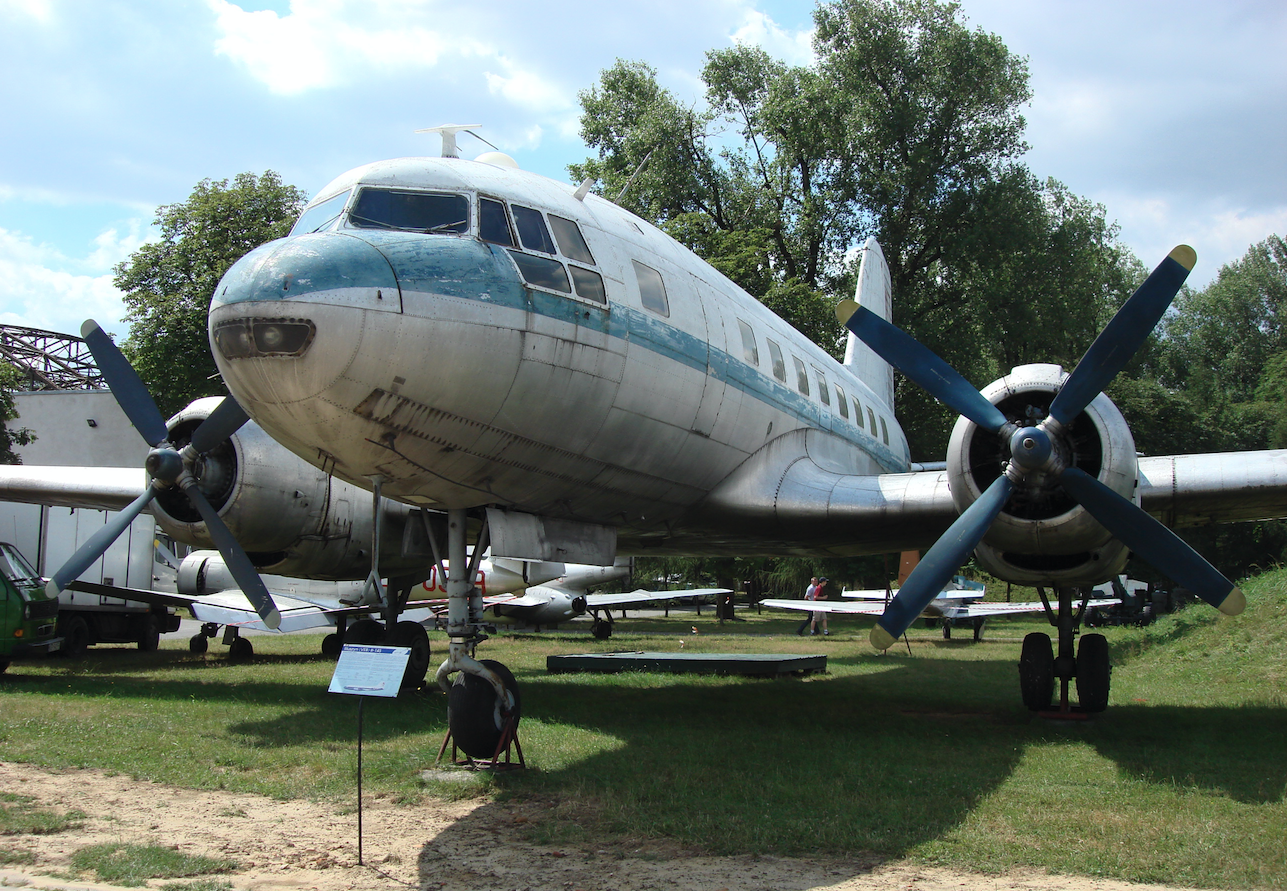
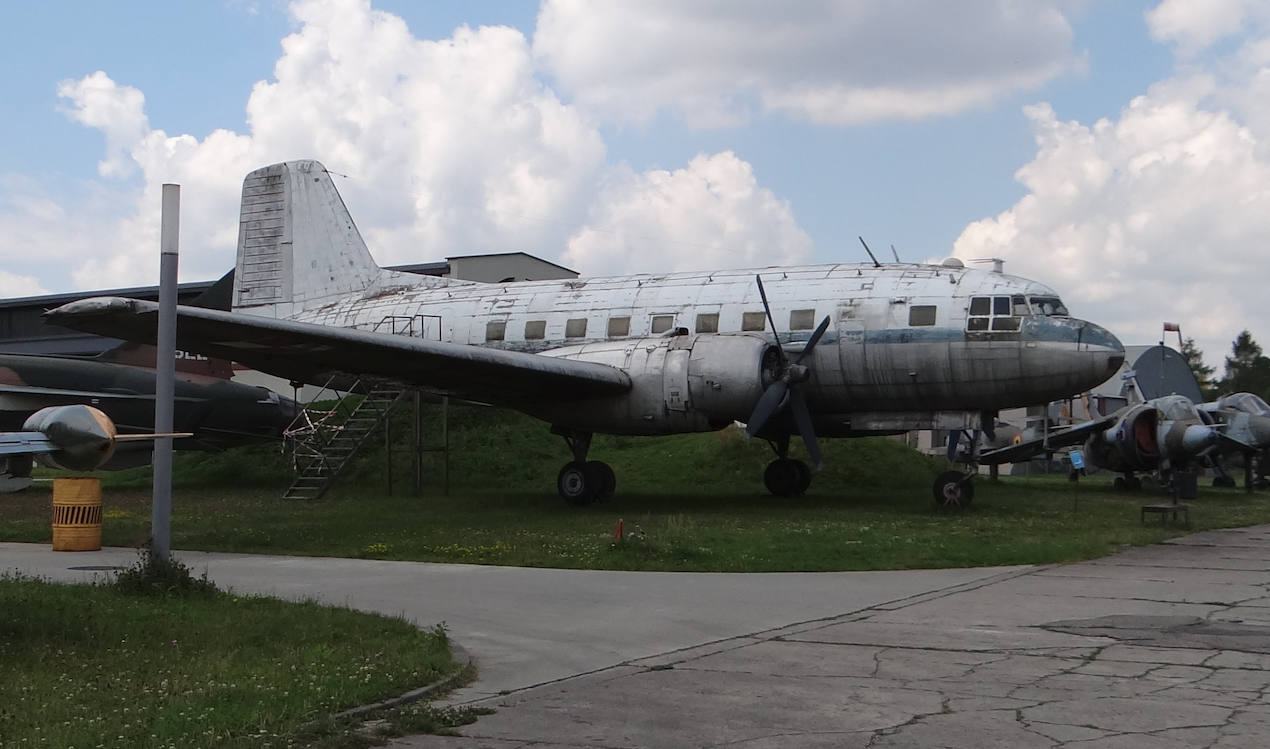
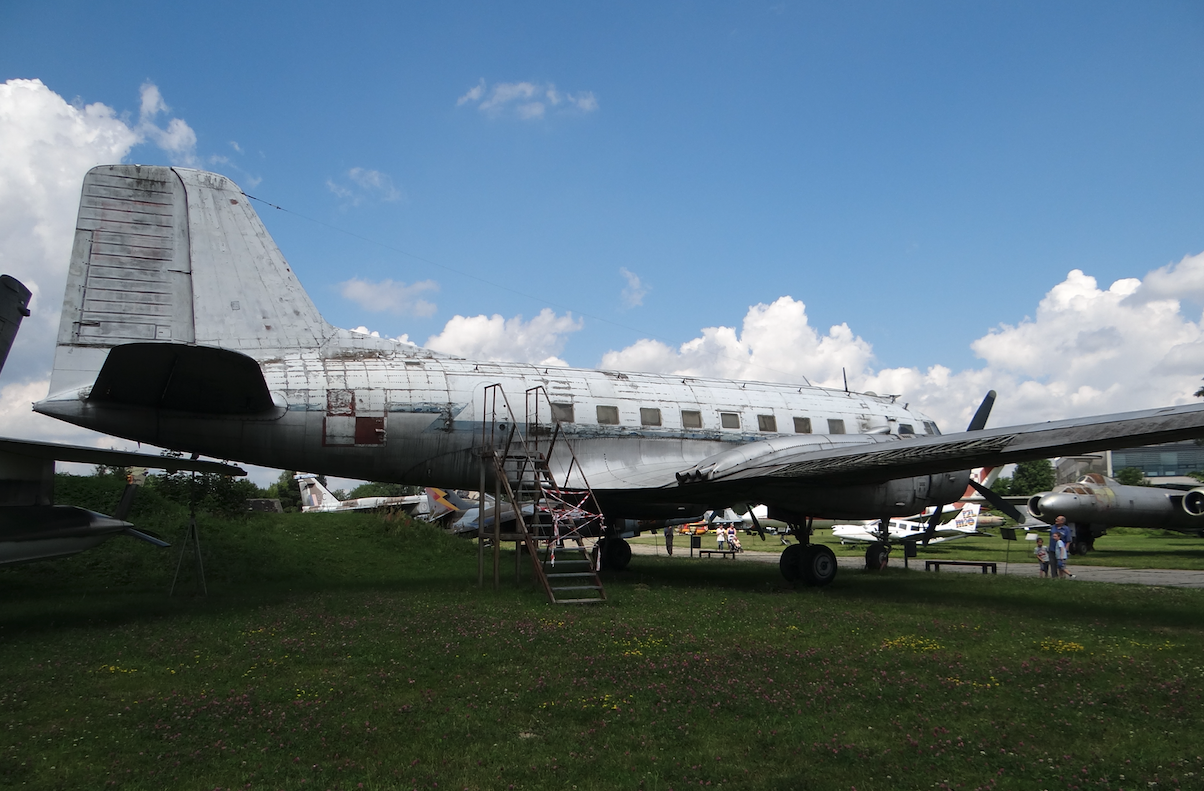
History Iliuszyn Ił-14.
Deficiencies in the Il-12 aircraft forced the necessity of further modification works. The changes were so big that a new plane was created. It was designated Il-14. The new aircraft after its predecessor inherited the fuselage structure, horizontal tail and landing gear. The wings were completely rebuilt. Higher power engines were used. The designers had at their disposal the ASz-82 T engine, with 2 x 1,398 kW start power (2 x 1 900 HP). These engines not only had more power than the previous variety, but were also more fuel-efficient.
Much attention was paid to increasing security, especially in complex situations. Belongs to them; fire on board. Interruption of one engine during start. Landing in conditions of limited earth visibility. Flight in conditions of strong icing. Much of this was achieved by introducing new avionics. Landing equipment in difficult weather conditions and new radio equipment for ground communication were built.
The Il-14 prototype made its first flight on September 20, 1950, and Vladimir K. Kokkinaki was the first pilot. The obtained test results were so encouraging that it was decided to build a full passenger version. The version received the designation Il-14 P, and in 1953, the aircraft made its first flight. The aircraft received a passenger cabin equipped with 18 seats. The total weight was 16 513 kg.
The production of Il-14 aircraft was started in Moscow by the "Znamia Truda" plant in 1954, replacing Il-12 aircraft on the production line. The aircraft was introduced to Aeroflot in November 1954. The first cruises allowed to gather comments and conclusions that led to the development of the IL-14 M version (modified - modernized). The hull was extended by 1 meter, which allowed 24 seats to be placed. Based on the same hull, a version with 32 seats was built, designated Il-14 M 32. These additional seats were installed thanks to the liquidation of the auxiliary (luggage) room and the reduction of the distance between rows.
There was also the Ił-14 T version, i.e. the transport version, without seats, with a reinforced floor and a large loading door on the port side. The Il-14 D version is the landing version for skydivers, with benches at the hull sides. The Il-14 F version is a photogrammetric version built in small numbers.
Production of Il-14 was completed at CCCP in 1958. Il-14 aircraft were also manufactured under license in East Germany and Czechoslovakia. The GDR industry started aircraft production in 1956 at the VEB Flugzeugewerke Dresden plant, under the designation VEB Ił-14. About 80 machines were built in the GDR, in various versions and versions. In Czechoslovakia, production started Avia Georgi Dimitrov. The aircraft were designated Av-14. The first copies were closely modeled on the Il-14 P and had 18 seats in the passenger cabin. The next version was Av-14-24, corresponding to the Soviet Il-14 M. In 1957, the Av-14-32 variant for 32 passengers was built, and in 1959, the Av-14-40 variant for 40 passengers, designed for short routes national. Versions were also created in Czechoslovakia; Av-14 T transport, with loading doors of 2.75 mx 1.60 m, Av-14 P for parachute landing. Airplanes were built in single copies; aerophotography and salons for important personalities (VIP). The production of Av-14 was completed in 1960, after the construction of over 200 machines.
According to the licensing laws, the planes built in East Germany and Czechoslovakia were to be identical to the smallest detail. However, these countries made many successful changes, and what is important, their machines were more carefully made.
Ił-14 aircraft, mainly in transport version, were used in the Warsaw Pact countries (Poland, USSR, Czechoslovakia, East Germany, Bulgaria, Romania, Hungary) and in Yugoslavia, China, Egypt, India, Indonesia, Congo, Nepal, Syria, Korea North, Myanmar, Albania, Mongolia, South Yemen, Ghana, Guinea, Iraq, Mali and Cuba.
In total, in the years 1954–1960, about 3,500 copies of all versions and varieties of the Il-14 aircraft were built. The aircraft enjoyed a good reputation. They were easy to fly, safe and economical for those times.
Il-14 in Poland. June 1955.
PLL LOT
LOT Polish Airlines purchased in CCCP, in 1955, four Ił-14 P aircraft, and in 1956, another two. In 1957, six VEB Ił-14 P machines and one passenger-transport Av-14 from Czechoslovakia were imported, with large loading doors. CCCP aircraft have been designated SP-LNA, SP-LNB, SP-LNC, SP-LND, SP-LNE, SP-LAF. Planes from the GDR were marked with the SP-LNG, SP-LNH, SP-LNJ, SP-LNK, SP-LNL, SP-LNM registrations. The aircraft from Czechoslovakia AV-14 received registration SP-LNN. In addition, in the years 1963–1964, PLL LOT rented three VEB Ił-14 P aircraft. They had different serial numbers, but they received registration SP-LNO, SP-LNP, SP-LNR. In total, LOT Polish Airlines operated 13 Ił-14 machines.
During operation at LOT, aircraft were subject to numerous modernizations. The number of passenger seats was increased from 18 to 26, and then 32. Dorsal astro domes were removed in Il-14 P. VEB Il-14 P aircraft did not have them at all. The wing (!) Was strengthened and an eighth window was added in the front of the passenger compartment as well as other minor changes.
In 1967, a decision was made to adapt two Ił-14 P aircraft to aerophotogrammetry tasks to replace the depleted Li-2 F. Two Soviet production SP-LNB and SP-LNE were rebuilt. The first of them was put into use in March 1968, and the second a few weeks later. Workshops overhauling PLL LOT aircraft were made. On the left side of the aircraft mounted a semicircular dome of organic glass in place of the radiotelegraph's cabin window, for the room of the navigation sight, used to track the photographed area. Most of the seats have been removed from the passenger compartment. Photographic equipment was installed. In the floor and at the bottom of the cab holes for the lens have been cut out. The lower opening is covered by a cover located outside the hull. The aircraft crew consists of; 2 pilots, radio operator, navigator, 2-4 operators of photographic equipment. These aircraft also inherited the painting pattern from Li-2 F. The aircraft were owned by the Polish Photogrammetry Enterprise, for which LOT Polish Airlines provided technical service and flying personnel. Later they were forwarded to Przedsiębiorstwo Lotnicze Aviation, which in their tasks received the aerophotogram department. Then, photogrammetric planes in Poland were the property of the Board of Air Traffic and Communications Airports.
Ił-14 passenger aircraft completed regular flights at LOT Polish Airlines in 1972, performing charter flights until 1974, giving way to the turboprop An-24 W and Ił-18.
Il-14 M SP-LNG registration.
One aircraft Il-14 M registration SP-LNG, at the beginning of the 70s, was equipped with a special measuring apparatus for testing the structure of the electromagnetic field and analyzing the spectrum of signals emitted by air sources. The design and equipment of the Ił-14 measuring version was developed at the request of the Ministry of Communication at the Institute of Aviation. In the 80's these machine was at the disposal of the Air Traffic Board and served as a universal flying electronic measuring laboratory. The equipment on board was classified as a unique technical solution.
On August 22, 1974, the Il-14 SP-LNB aircraft was sold to Przedsiębiorstwo Usług Lotniczych. Measuring apparatus has been mounted on it, which we write about below. In new tasks, the aircraft replaced the worn-out Lisunow Li-2 aircraft registration SP-LKE "Ewa". This enterprise underwent further transformations, becoming the Board of Air Traffic and Communications Airports, and then (80s) by the State Enterprise Porty Lotnicze.
The purpose of the existence of this aircraft with the equipment mounted on it was to ensure safety in civil traffic along the corridors above Poland. Each passenger aircraft has systems that process VOR beacons and a receiver with a cross indicator at the output. According to this indicator, the pilot is aware of the position of the aircraft in the corridor and corrects it. Measuring equipment was on board the SP-LNB aircraft, and the map of Poland with air corridors was laid out all the time on the table. The aircraft cooperated with non-directional VOR beacons deployed throughout the country and landing devices based on ILS type instruments installed at airports. The heart of the system on the plane was a computer that analyzed ground signals. The floppy disks, which are computer memory media, contained data for each controlled device. Current signals from the given device were saved on clean floppy disks. The computer performs a comparative analysis of the received signal with the pattern, including floppy disks. Thanks to this, it was known whether the device was working properly. Measurements are displayed on a small screen in the form of graphs. These charts were then printed. All this took place on board the aircraft. Flights to test ILS equipment were much more difficult for the crew. The pilot had to stay perfectly on the glide path. At Okęcie, to make one full measurement, it was necessary to spend 35 hours in the air, while where the terrain is difficult to level, for example in Balice, a total of 100 hours had to be in the air. The manufacturer of this equipment was the American company Aviation Systems Incorporation.
In the 80's, Porty Lotnicze company had two Il-14 aircraft, but only one of them was fitted with the equipment mentioned above. Specifically on SP-LNB. The aircraft flew only over Polish territory, including territorial waters. For example, in the Darłowo region, the plane flew over the sea over a distance of 40 km. In order for the measurements to be as good as possible, the right weather had to be maintained, the cloud base 900 m, visibility 10,000 m, which is why the most outlets were in summer.
In 1990, the Il-14 SP-LNB registration terminated service, and specialized equipment was transferred to the Turbolet L-410 aircraft. SP-LNB and SP-LNE aircraft as wrecks survived their days at Okęcie (2005).
Il-14 in the Polish Army. 1955.
Polish Military Aviation, the first IL-14 machines received in 1955, and they were planes available, as a showroom. They wore nb 001, 004, 010 and others as well as transport and landing with nb 005, 006 and others. It should be noted that several IL-14 aircraft from PLL LOT were on military aviation services. For example, these aircraft were used to transport fruit.
In addition to Soviet aircraft, the army had machines built in East Germany type VEB Il-14 T. These aircraft were mainly used for taking skydivers, aerophotogrammetry and for transporting cargo. Machines used in the army had slightly changed radio navigation equipment. This was visible after using a different type of antenna on the hull back. Military planes also have a semi-circular dome in place of the radiotelegraphist's cabin window for locating the target sight. The cargo door is located on the starboard side, in the rear of the hull. It opens only on the ground in an upward motion, just like on a Lisunow Li-2 plane. The doors have smaller doors that are used by skydivers. They open inside.
In 1961, attempts were made on the Il-14 aircraft to drop suspended containers for bomb locks and dropped on parachutes. These machines had beams with bomb locks mounted under the middle wing-fuselage. A mirror was placed on the engine nacelle to observe the moment of dropping.
The jumpers of the 6th Pomeranian Airborne Division used the Il-14 T aircraft. Both during training and during rescue operations. This type of machine was dropped in July 1958 during a campaign to help people affected by floods. In October 1962, during the exercises of the Warsaw Pact state, airborne operations were carried out in Western Pomerania with these aircraft. Similarly, in 1966, in the Ustka region, during naval exercises. IL-14 planes performed their tasks back in the 70's, although they gradually gave way to turboprop-powered aircraft.
College of Aviation in Dęblin used Ił-14 T aircraft to train navigators. The future navigator was trained in the cockpit and only one. In 1975, a team of WOSL rationalizers modified one IL-14 T aircraft for this purpose. Its hold has been rebuilt into a flying lecture hall, allowing the simultaneous training of 6 navigators, at tables with appropriate radio navigation equipment. In addition, it was possible to conduct training in horizontal bombardment and to recognize the effects of bombing. Previously Lisunow Li-2 aircraft were used for this purpose.
In the 1960s, one copy of the Il-14 E was introduced to the armament. The aircraft was equipped with specialized electronic reconnaissance equipment. Probably all the equipment was installed in Poland and is an original Polish solution. It would also mean that even our then allies were not very aware of its existence. Except for checker boards arranged by plane, there were no inscriptions. His crew consisted of 10 pilots. He performed flights mainly on the Baltic Sea. The plane was one of the closely guarded military secrets. To this day (2008) the equipment of the aircraft is not widely known.
There were a total of 17 IL-14 machines in the state of military aviation. They served exceptionally long. Generally, by the end of the 1980s. But the last Il-14 was written off in 1997.
Versions Ił-14.
Ił-14 P - basic passenger version. Produced since 1950, in CCCP and GDR. The aircraft had 18 passenger seats. The number of passenger seats was increased to 28 and 32. Production ended in 1957.
Ił-14 M - version of the Ił-14 P with the hull extended by 1 m. Developed in 1955. Passenger variety for 24 people, then 28 people and 32 people. The plane had slightly worse performance than the version from which it was made.
Il-14 G - transport, but civil version. Derived from the Il-14 M version, but has the hull of the Il-14 P version, it carries 3,500 kg of cargo. A small series of these aircraft was built by converting existing machines. The aircraft were mainly used to service science and research stations in the polar regions.
Ił-14 T - transport and military version. The aircraft was developed in 1952, based on the Il-14 M version, but with the hull of the Il-14 P version. Normally, 21 paratroopers or 18 wounded or 2,700 kg of cargo were taken on board. The aircraft could tow two gliders with a total weight of up to 7,000 kg.
Il-14 D - landing version. The aircraft was developed in 1953 for airborne troops. He takes 30 paratroopers or 3 000 kg of cargo on board.
Avia AV-14 - Il-14 P aircraft built in Czechoslovakia.
Avia 14 Super - passenger for 42 passengers produced in Czechoslovakia.
Il-14 FG - photogrammetric version built on the basis of Il-14 G with extended glass nose.
Ił-14 FK - photogrammetric version built on the basis of Ił-14 P.
Ił-14 FKM - photogrammetric version built on the basis of Ił-14 M.
Ił-14 S - version of the lounge for important people (VIP) with 9-11 seats. Built on the basis of Il-14 P.
Il-14 E - electronic recognition version.
Written by Karol Placha Hetman
Kraków 2008-10-17
125b Section 1955-06-01
Iliuszyn Ił-14
Poland
Transport plane. Successor to the Il-12 aircraft.
Construction
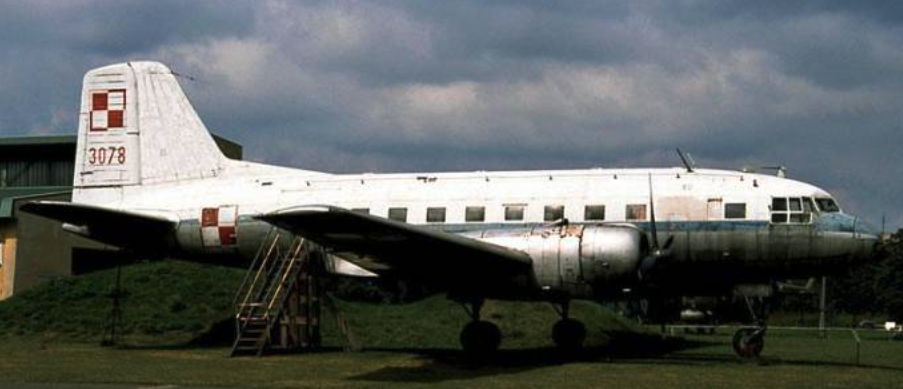

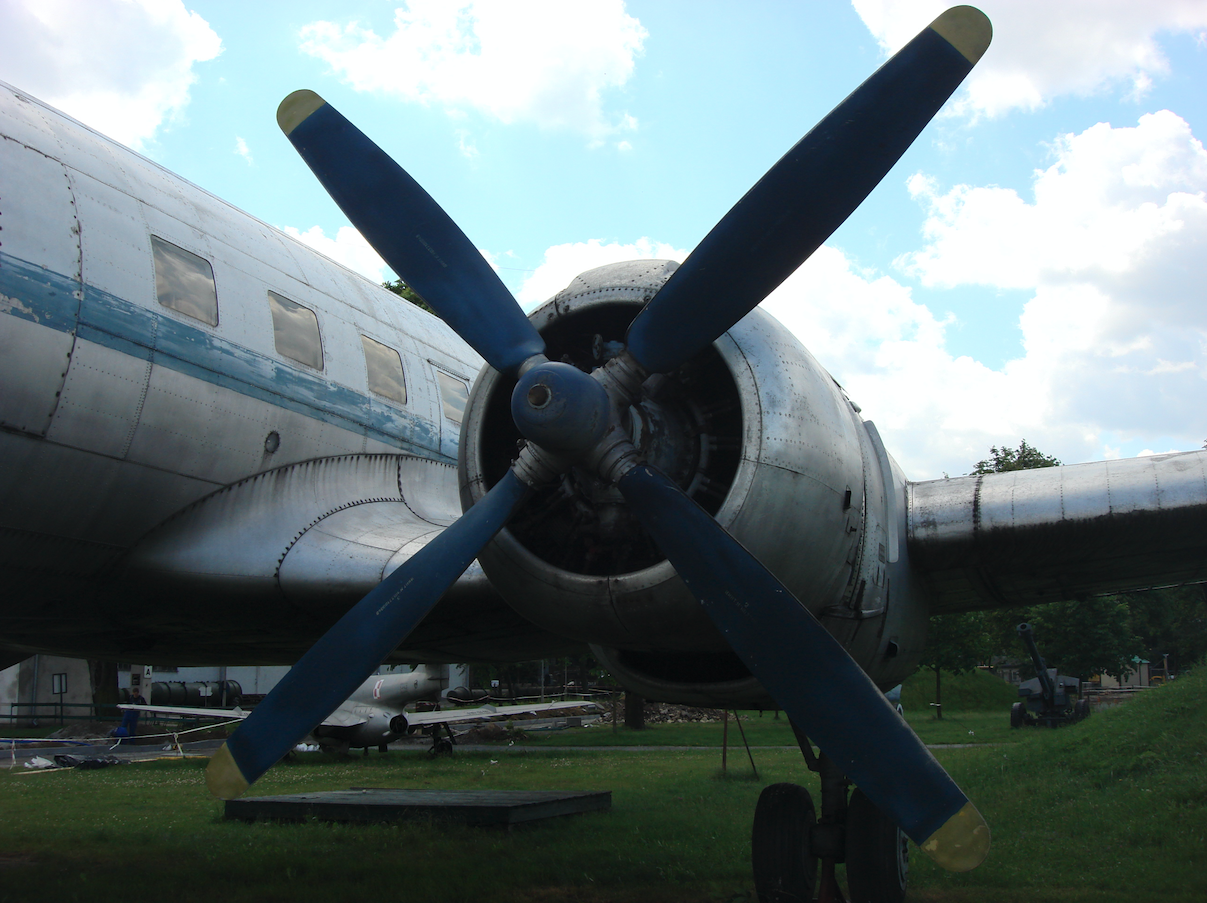
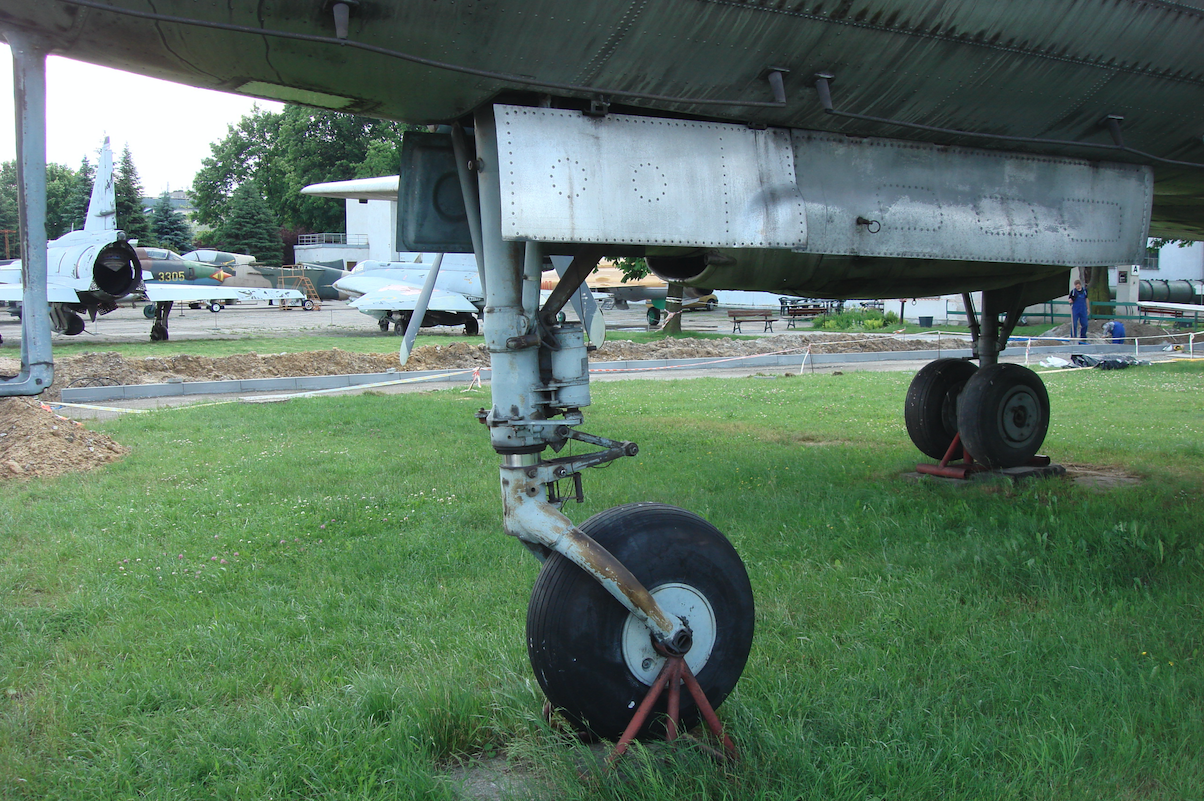
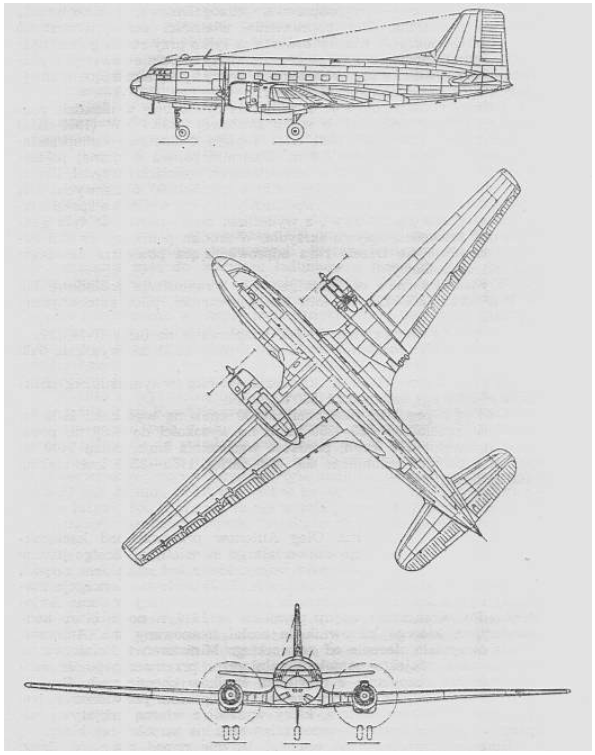
Construction Ił-14.
Passenger, transport and landing aircraft, used to transport people, transport cargo, drop skydivers, transport wounded, aerophotogrammetry and others. Planes used in Poland took 18-32 soldiers or 3,500 kg of cargo on board.
Iliuszyn Ił-14 is a twin-engine low-wing aircraft with a three-chassis retractable in flight. Full metal half-shell construction.
Three-folded wings with working cover. The center wing has a box-type girder and forms a whole with engine nacelles. The center wing was equipped with crocodile flaps. The external parts are easily attached and have a three-girder structure. Shuttlecocks covered with canvas, there is a trimmer on the right shuttlecock. The outer wings have a slight rise. The all-metal slotted flaps are swiveled to take off at an angle of 20 degrees and landing by 45 degrees. The leading edges are de-iced with warm air flowing in the internal channels. The bottom surface has retractable landing, taxiing and take-off lights, 700 W each. The fuselage of the half-shell structure houses in the front part a crew cabin consisting of; two pilots, on-board mechanic and radiotelegraph navigator. The deck mechanic sits between the pilots in a folding chair. The navigator sits on the right behind the second pilot. The front windows of the crew cabin are de-iced with warm air. Landing reflectors were also placed in the nose. Behind the crew cab there is an equipment compartment with communication and navigation devices as well as central hydraulics and a fire extinguisher system. Further on the left side of the passenger version there is a front trunk with a hatch on the left side. On the right side there is a small place to prepare meals. The original passenger cabin had 18 seats in a 2 + 1 arrangement in 6 rows. By changing all the seats to double the number of seats increased to 24, and the liquidation of the front trunk was added row of seats by this number of seats increased to 28. The next change consisting in reducing the spacing between rows led to the eighth row, which gave 32 seats. Seats did not have individual headboards and were rather rail-type couches. The CCCP even used a seating arrangement for up to 40 people. At the back, behind the entrance behind the curtain, there is room for passengers' covers. Toilet on the right, small luggage compartment on the left. Behind the trunk is the passage to the tail of the fuselage housing the altimeter radio equipment and signal flare launchers. In the transport version of the aircraft, in the central part there is a cargo compartment with metal benches folded under the walls. In the rear, an additional small loading compartment for light loads. The fuselage cross-section is circular, and in the thickest sections the diameter is 2.8 m. Non-encapsulated cabins.
Classic, self-supporting. Ballasts covered with sheet metal, rudders made of canvas. Trimmers (balancing tabs) are mounted on all rudders. The leading edge of the horizontal tail is defrosted with warm air.
Three-support, single-gen chassis with oil-air cushioning. Front with one wheel. Main double. The chassis chamber hatches are only open when the chassis is extended and retracted. In the chassis position, the open-flaps remain closed. This protects the chambers against dirt and improves aerodynamics. The average operating ceiling does not exceed 4,000 m above sea level, and results from the use of a non-hermetic cabin. However, when using oxygen masks for the crew, the aircraft was able to operate at a ceiling of 6,500 m. The airframe's service life was 20,000 hours with repair intervals of 4,200 hours. On average, Polish airplanes spent about 1,200 hours / year in the air.
Ił-14 drive.
Two 14-cylinder piston engines in the ASz-82 T double star system with 2 x 1 398.4 kW (2 x 1 900 HP) starting power. Nominal power 2 x 1 199 kW (2 x 1 630 HP). The tailpipes are placed in a jet pattern, which reduces the risk of fire and improves aerodynamics. There are two exhaust pipes, and between them a third pipe is placed, which is the outlet of the engine cooling system and exhaust manifolds. Air heat exchangers are located directly on the exhaust manifolds. Air at a temperature of about 90 degrees C was directed to the channels de-icing the leading edges of the wings and for heating the cabin. 4-blade self-aligning propellers AW-50 with a diameter of 3.8 m.
Fuel tanks with a total capacity of 3 520 liters are located in the outer parts of the wings. Fuel consumption is about 450 kg / h of flight. Oil tanks 2 x 142 liters were placed in engine nacelles.
Avionics equipment Ił-14.
Three on-board radio stations of the KF and VHF range. ILS / VOR system for flight without ground visibility. Automatic remote control AP-45.
Data T-T Ił-14.
Span 31.70 m, length 22.31 m, height 7.80 m, load surface 100 m2, curb weight 12 700 kg, total weight 17 500 kg, load weight 3 300 - 3 500 kg, fuel 3 520 liters, speed maximum 430 km / h, cruising speed 280-350 km / h, climb speed 5.0 m / s, landing speed 135 km / h, maximum range 2 250 km, range with a maximum load of 600 km, maximum ceiling 7 400 m, run-up 485 m, reach 443 m.
Written by Karol Placha Hetman
Kraków 2008-10-17
125b Section 1955-06-01
Iliuszyn Ił-14
Poland
Tally
For PLL LOT.
1 Ił-14 P registration SP-LNA purchased in CCCP for LOT Polish Airlines in 1955.
2 Ił-14 P registration SP-LNB No. 4340510 (?) Purchased at CCCP for LOT on July 4, 1955. In 1967 the aircraft were rebuilt for aerophotogrammetry and taken over by the State Photogrammetry Enterprise. On August 22, 1974. the aircraft was sold to Przedsiębiorstwo Usług Lotniczych. The ILS / VOR ground control measuring apparatus was installed on it. Ends his life at Okęcie (2008).
3 Ił-14 P registration SP-LNC purchased in CCCP for LOT in 1955. Alternatively, it is VEB Ił-14 P No. 4340509 bought in East Germany.
4 Ił-14 P registration SP-LND bought in CCCP for LOT in 1955.
5 Ił-14 P registration SP-LNE No. 6341602 (?) Purchased at CCCP for LOT in 1956. In 1967 the aircraft were rebuilt for aerophotogrammetry and taken over by the State Photogrammetry Enterprise. Ends his life at Okęcie (2008).
6 Ił-14 P registration SP-LNF purchased in CCCP for LOT in 1956.
7 VEB Ił-14 P registration SP-LNG No. 1480310 (?) Purchased in the GDR for LOT in 1957. At the beginning of the 70s, it was equipped with special measuring apparatus for testing the structure of the electromagnetic field and analyzing the spectrum of signals emitted by air sources.
8 VEB Ił-14 P registration SP-LNH No. 14803012 (?) Purchased in the GDR for LOT in 1957.
9 VEB Ił-14 P registration SP-LNJ purchased in the GDR for LOT in 1957.
10 VEB Ił-14 P registration SP-LNK purchased in the GDR for LOT in 1957.
11 VEB Ił-14 P registration SP-LNL No. 14803017 (?) Purchased in the GDR for LOT in 1957.
12 VEB Ił-14 P registration SP-LNM No. 14803010 (?) Purchased in the GDR for LOT in 1957. Probably also rebuilt into a photogrammetric plane, because it received painting like a popular Parrot. After the end of operation in the 90s, it was stored in Lublinek with a modified registration for SP-ENM, and later as a cafe in Boguchwała (2004, 2006).
13 AV-14 / Ił-14 PT registration SP-LNN No. 703108 purchased in Czechoslovakia for LOT in 1957.
14 VEB Ił-14 P registration SP-LNO borrowed for LOT in 1963. - 1964
15 VEB Ił-14 P registration SP-LNP borrowed for LOT in 1963. - 1964
16 VEB Ił-14 P registration SP-LNR borrowed for LOT in 1963. - 1964
The 17 Ił-14 machines of Soviet and German production were purchased for the army.
The Il-14 aircraft in the army initially received order numbers, three-digit. Later they received four-digit numbers, which are the ends of serial numbers. In general, Il-14 aircraft were operated in the army until the end of the 1980s. The last machine was written down in 1997.
1 Il-14 S nb 001 for the army.
2 Il-14 nb 002 for the army. He served in Dęblin to train navigators, initially one, and after modernization six at the same time.
3 Il-14 nb 003 for the army.
4 Il-14 S nb 004 for the army.
5 Il-14 TD nb 005 for the army.
6 Il-14 TD nb 006 for the army.
7 Il-14 nb 007 for the army.
8 Ił-14 nb 008 for the army.
9 Il-14 nb 009 for the army.
10 Ił-14 S nb 010 for the army. Private car.
11 Il-14 E for the army. A specialized version for conducting electronic reconnaissance over the Baltic Sea. Probably fully equipped in Poland, i.e. bought as a regular transport plane. In addition to the regular chessboards, there were no inscriptions on the hull. Used mainly in the 1960s. One of the most guarded aircraft in Poland.
12 Ił-14 nb 0606 No. 14800606 for the army. After leaving the service, he went to the USA.
13 Ił-14 nb 0916 No. 14800916 for the army. After leaving the service in Lublinek.
14 Il-14 T nb 3054 No. 14803054 for the army. The plane went to the museum in Skarżysko Kamienna.
15 Ił-14 P nb 3073 for the army. After the end of operation as a cafe in Lutcza (2004).
16 Il-14 S nb 3078 for the army. Private car. The aircraft was manufactured in East Germany. In stock at the 36th Special Aviation Regiment. After leaving the museum in Czyżyny (2005 2008). Its interior is sporadically open to visitors.
17 Il-14 for the army.
Written by Karol Placha Hetman
